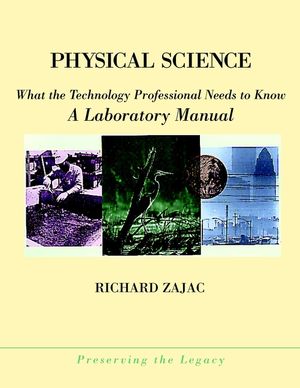Physical Science: What the Technology Professional Needs to Know: A Laboratory ManualISBN: 978-0-471-36019-3
Paperback
440 pages
January 2001
 This is a Print-on-Demand title. It will be printed specifically to fill your order. Please allow an additional 10-15 days delivery time. The book is not returnable.
|
||||||
Table of Contents.
Preface.
Acknowledgments.
Note to the Student.
Experiment/Text Correlation and Student Objectives.
Concrete: A Common Mixture.
Density-Buoyancy Relationships.
Uncertainty, Error Bars, and Calibration.
Percent Composition and Error Analysis.
Estimating the Atomic Mass of Metals.
Using Spreadsheets to Analyze Objects in Motion.
Objects in Motion.
Momentum and Friction in a Car Crash: A Forensic Investigation.
Waves and Oscillations.
Simple Machines.
Volume and Temperature Relationships of Gases.
Energy.
Heat of Reaction.
Exploration of Acids and Bases.
Acid Concentrations and Strengths.
Percent of Acetic Acid in Vinegar: An Acid/Base Titration.
Build Your Own Voltmeter.
Build Your Own Ammeter.
Refraction.
Diffraction Gratings.
Optics of Thin Lenses.
Spectrophotometry.
Molecular Models.
Organic Esters.
Using Properties to Identify Organic Families.
Simulating Nuclear Processes.
Supplemental Exercises in Physics and Chemistry.
Appendix A -
Common Temperature Measurements.
Appendix B -
Prefixes Used with SI Fundamental Units.
Appendix C -
Derived Units.
Preface.
Acknowledgments.
Note to the Student.
Experiment/Text Correlation and Student Objectives.
Concrete: A Common Mixture.
Density-Buoyancy Relationships.
Uncertainty, Error Bars, and Calibration.
Percent Composition and Error Analysis.
Estimating the Atomic Mass of Metals.
Using Spreadsheets to Analyze Objects in Motion.
Objects in Motion.
Momentum and Friction in a Car Crash: A Forensic Investigation.
Waves and Oscillations.
Simple Machines.
Volume and Temperature Relationships of Gases.
Energy.
Heat of Reaction.
Exploration of Acids and Bases.
Acid Concentrations and Strengths.
Percent of Acetic Acid in Vinegar: An Acid/Base Titration.
Build Your Own Voltmeter.
Build Your Own Ammeter.
Refraction.
Diffraction Gratings.
Optics of Thin Lenses.
Spectrophotometry.
Molecular Models.
Organic Esters.
Using Properties to Identify Organic Families.
Simulating Nuclear Processes.
Supplemental Exercises in Physics and Chemistry.
Appendix A -
Common Temperature Measurements.
Appendix B -
Prefixes Used with SI Fundamental Units.
Appendix C -
Derived Units.



